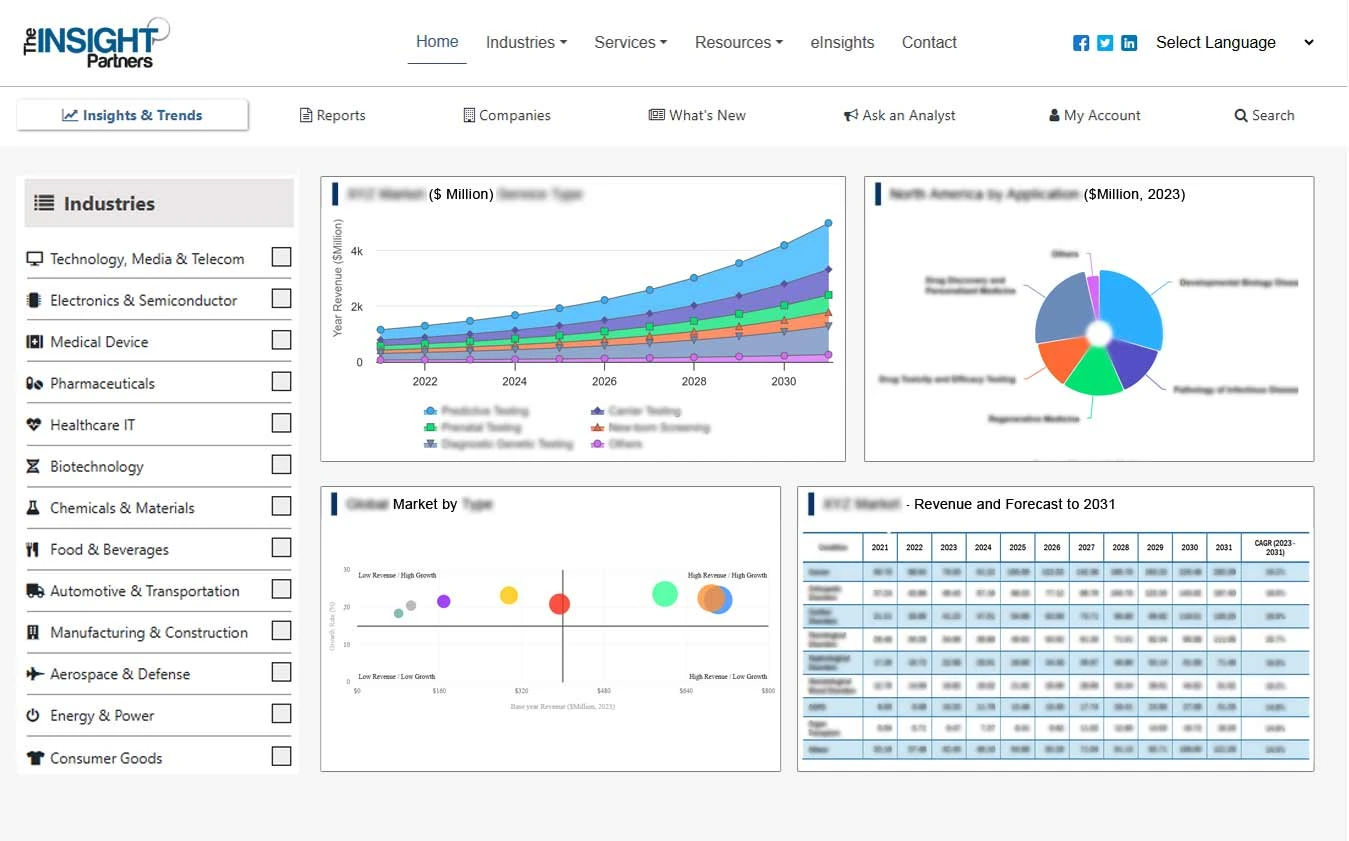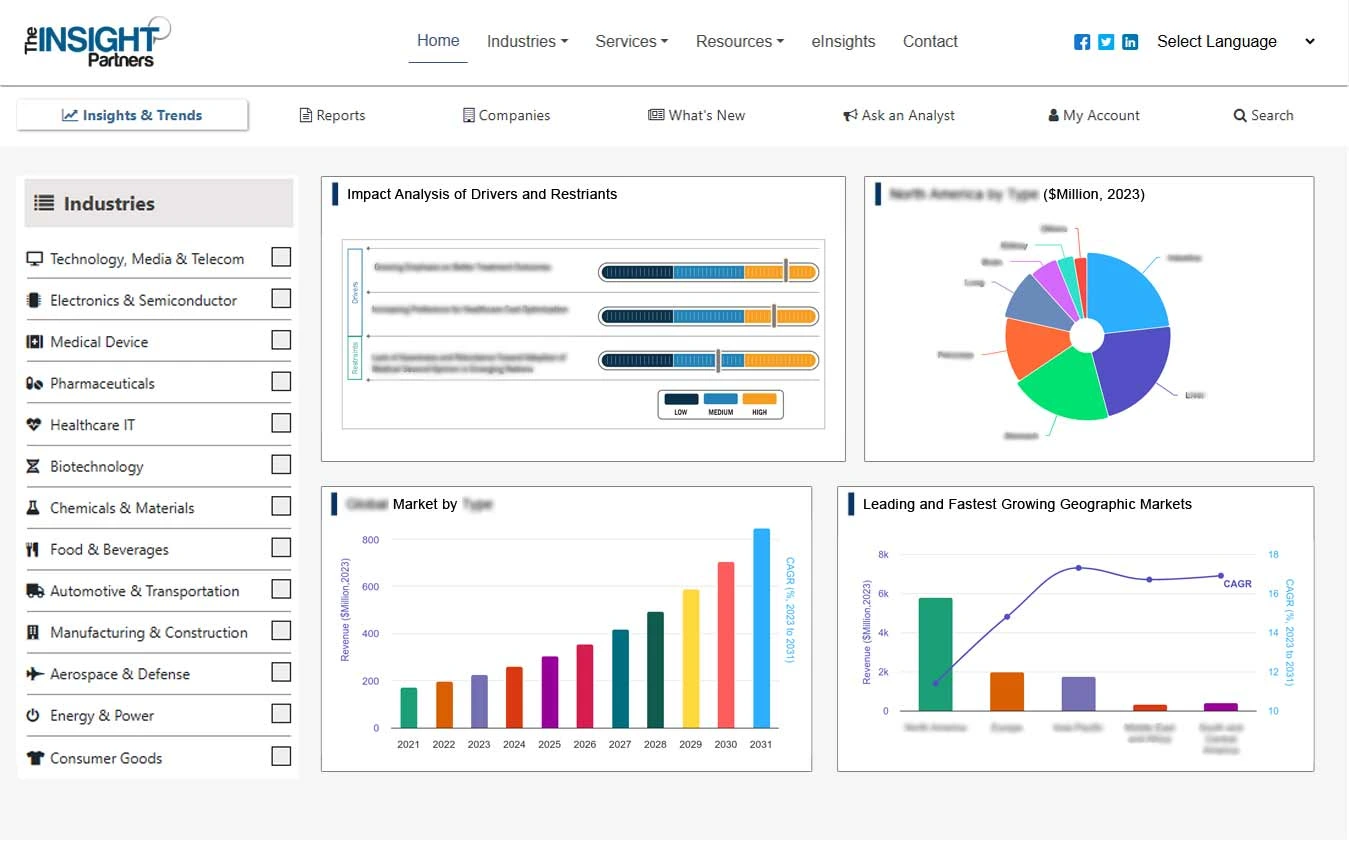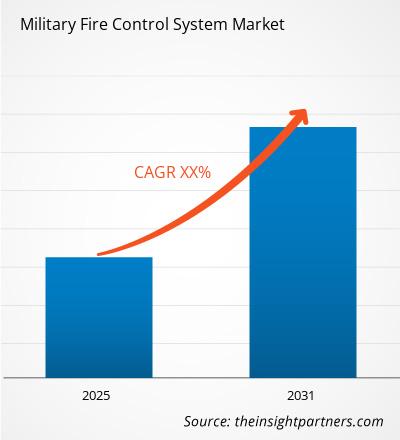تم تصميم نظام التحكم في الحرائق لمساعدة نظام الأسلحة بعيدة المدى في استهداف الهدف وتتبعه وضربه. يتم دمج أنظمة مكافحة الحرائق العسكرية في الأسلحة والمركبات والطائرات والأساطيل البحرية. تساعد أنظمة التحكم في النيران في التصويب غير الدقيق للهدف واكتشافه وتتبعه وضربه، بالإضافة إلى تعزيز فعالية العمليات العسكرية.
ديناميكيات السوق
تركز الشركات الرئيسية على تطوير دقة الأسلحة القتالية وتحاول تقليل وقت التصويب للنظام. ومن ثم، يعمل هذا العامل كمحرك لسوق أنظمة التحكم في الحرائق العسكرية. ومع ذلك، فإن عوامل مثل حواجز الدخان تعيق نمو سوق أنظمة التحكم في الحرائق العسكرية. علاوة على ذلك، فإن استخدام أنظمة التحكم في الحرائق للجنود لتعزيز فعالية العمليات العسكرية يخلق فرصًا كبيرة لسوق أنظمة التحكم في الحرائق العسكرية.
نطاق السوق
"تحليل سوق أنظمة التحكم في الحرائق العسكرية العالمية حتى عام 2031" هو تقرير متخصص ومتخصص في - دراسة متعمقة مع التركيز بشكل خاص على تحليل اتجاهات السوق العالمية. يهدف التقرير إلى تقديم لمحة عامة عن سوق أنظمة التحكم في الحرائق العسكرية العالمية مع تجزئة السوق التفصيلية حسب النظام والمنصة والتطبيق والجغرافيا. من المتوقع أن يشهد سوق أنظمة التحكم في الحرائق العسكرية العالمية نموًا مرتفعًا خلال الفترة المتوقعة. يقدم التقرير إحصائيات أساسية عن حالة السوق للاعبين الرائدين في سوق أنظمة التحكم في الحرائق العسكرية ويقدم الاتجاهات والفرص الرئيسية في السوق.
تقسيم السوق
السوق العالمية لأنظمة التحكم في الحرائق العسكرية مقسمة حسب النظام والمنصة والتطبيق. على أساس النظام، فإن سوق أنظمة التحكم في الحرائق العسكرية هو أنظمة الملاحة وأنظمة الطاقة والأنظمة المساعدة وكمبيوتر المقذوفات ووحدات العرض والواجهة وغيرها. على أساس المنصة، يتم تقسيم سوق أنظمة التحكم في الحرائق العسكرية إلى مركبات مثبتة على الأسلحة ومثبتة على المركبات. بناءً على التطبيق، يتم تقسيم سوق أنظمة التحكم في الحرائق العسكرية إلى أنظمة بحرية وبرية وجوية.
يقدم التقرير نظرة عامة مفصلة عن الصناعة بما في ذلك المعلومات النوعية والكمية. ويقدم لمحة عامة وتوقعات لسوق أنظمة التحكم في الحرائق العسكرية العالمية بناءً على مختلف القطاعات. كما يوفر حجم السوق والتقديرات المتوقعة من عام 2021 إلى 2031 فيما يتعلق بخمس مناطق رئيسية، وهي؛ أمريكا الشمالية وأوروبا وآسيا والمحيط الهادئ (APAC) والشرق الأوسط وأفريقيا (MEA) وأمريكا الجنوبية. يتم تقسيم سوق أنظمة التحكم في الحرائق العسكرية حسب كل منطقة لاحقًا حسب البلدان والقطاعات المعنية. يغطي التقرير التحليل والتوقعات لثمانية عشر دولة على مستوى العالم جنبًا إلى جنب مع الاتجاه الحالي والفرص السائدة في المنطقة.
يحلل التقرير العوامل التي تؤثر على سوق أنظمة التحكم في الحرائق العسكرية من جانب الطلب والعرض ويقيم كذلك ديناميكيات السوق التي تؤثر على السوق خلال الفترة المتوقعة، أي السائقين والقيود والفرص والاتجاه المستقبلي. ويقدم التقرير أيضًا تحليل القوى الخمس الشامل لبورتر حول السيناريو العالمي.
اللاعبون في السوق
تغطي التقارير التطورات الرئيسية في سوق أنظمة التحكم في الحرائق العسكرية كاستراتيجيات نمو عضوية وغير عضوية. تركز العديد من الشركات على استراتيجيات النمو العضوي مثل إطلاق المنتجات والموافقات على المنتجات وغيرها مثل براءات الاختراع والأحداث. كانت أنشطة استراتيجيات النمو غير العضوية التي شهدها السوق هي عمليات الاستحواذ والشراكة والشراكة. التعاون. وقد مهدت هذه الأنشطة الطريق لتوسيع الأعمال التجارية وقاعدة العملاء من اللاعبين في السوق. من المتوقع أن يوفر اللاعبون في السوق من سوق أنظمة التحكم في الحرائق العسكرية فرص نمو مربحة في المستقبل مع تزايد الطلب على محامل الطيران في السوق العالمية. فيما يلي قائمة ببعض الشركات العاملة في سوق أنظمة التحكم في الحرائق العسكرية.
يتضمن التقرير أيضًا ملفات تعريفية للشركات الرئيسية إلى جانب تحليل SWOT واستراتيجيات السوق في سوق أنظمة التحكم في الحرائق العسكرية. بالإضافة إلى ذلك، يركز التقرير على اللاعبين الرائدين في الصناعة بمعلومات مثل ملفات تعريف الشركة والمكونات والخدمات المقدمة والمعلومات المالية للسنوات الثلاث الماضية والتطور الرئيسي في السنوات الخمس الماضية.
- • Aselsan AS • BAE Systems• Elbit Systems Ltd• شركة General Dynamics Mission Systems, Inc.• Leonardo SpA• شركة لوكهيد مارتن• شركة رايثيون• Rheinmetall AG• Saab AB• Safran
يتكون فريق البحث والتحليل المخصص لدى Insight Partner من محترفين ذوي خبرة يتمتعون بخبرة إحصائية متقدمة ويقدمون خيارات تخصيص متنوعة في الدراسة الحالية.
- التحليل التاريخي (سنتان)، السنة الأساسية، التوقعات (7 سنوات) مع معدل النمو السنوي المركب
- تحليل PEST و SWOT
- حجم السوق والقيمة / الحجم - عالميًا وإقليميًا وقطريًا
- الصناعة والمنافسة
- مجموعة بيانات Excel



Report Coverage
Revenue forecast, Company Analysis, Industry landscape, Growth factors, and Trends

Segment Covered
This text is related
to segments covered.

Regional Scope
North America, Europe, Asia Pacific, Middle East & Africa, South & Central America

Country Scope
This text is related
to country scope.
1. Aselsan A.S.2. BAE Systems3. Elbit Systems Ltd.4. General Dynamics Mission Systems, Inc.5. Leonardo S.p.A.6. Lockheed Martin Corporation7. Raytheon Company8. Rheinmetall AG9. Saab AB10. Safran
The Insight Partners performs research in 4 major stages: Data Collection & Secondary Research, Primary Research, Data Analysis and Data Triangulation & Final Review.
- Data Collection and Secondary Research:
As a market research and consulting firm operating from a decade, we have published and advised several client across the globe. First step for any study will start with an assessment of currently available data and insights from existing reports. Further, historical and current market information is collected from Investor Presentations, Annual Reports, SEC Filings, etc., and other information related to company’s performance and market positioning are gathered from Paid Databases (Factiva, Hoovers, and Reuters) and various other publications available in public domain.
Several associations trade associates, technical forums, institutes, societies and organization are accessed to gain technical as well as market related insights through their publications such as research papers, blogs and press releases related to the studies are referred to get cues about the market. Further, white papers, journals, magazines, and other news articles published in last 3 years are scrutinized and analyzed to understand the current market trends.
- Primary Research:
The primarily interview analysis comprise of data obtained from industry participants interview and answers to survey questions gathered by in-house primary team.
For primary research, interviews are conducted with industry experts/CEOs/Marketing Managers/VPs/Subject Matter Experts from both demand and supply side to get a 360-degree view of the market. The primary team conducts several interviews based on the complexity of the markets to understand the various market trends and dynamics which makes research more credible and precise.
A typical research interview fulfils the following functions:
- Provides first-hand information on the market size, market trends, growth trends, competitive landscape, and outlook
- Validates and strengthens in-house secondary research findings
- Develops the analysis team’s expertise and market understanding
Primary research involves email interactions and telephone interviews for each market, category, segment, and sub-segment across geographies. The participants who typically take part in such a process include, but are not limited to:
- Industry participants: VPs, business development managers, market intelligence managers and national sales managers
- Outside experts: Valuation experts, research analysts and key opinion leaders specializing in the electronics and semiconductor industry.
Below is the breakup of our primary respondents by company, designation, and region:

Once we receive the confirmation from primary research sources or primary respondents, we finalize the base year market estimation and forecast the data as per the macroeconomic and microeconomic factors assessed during data collection.
- Data Analysis:
Once data is validated through both secondary as well as primary respondents, we finalize the market estimations by hypothesis formulation and factor analysis at regional and country level.
- Macro-Economic Factor Analysis:
We analyse macroeconomic indicators such the gross domestic product (GDP), increase in the demand for goods and services across industries, technological advancement, regional economic growth, governmental policies, the influence of COVID-19, PEST analysis, and other aspects. This analysis aids in setting benchmarks for various nations/regions and approximating market splits. Additionally, the general trend of the aforementioned components aid in determining the market's development possibilities.
- Country Level Data:
Various factors that are especially aligned to the country are taken into account to determine the market size for a certain area and country, including the presence of vendors, such as headquarters and offices, the country's GDP, demand patterns, and industry growth. To comprehend the market dynamics for the nation, a number of growth variables, inhibitors, application areas, and current market trends are researched. The aforementioned elements aid in determining the country's overall market's growth potential.
- Company Profile:
The “Table of Contents” is formulated by listing and analyzing more than 25 - 30 companies operating in the market ecosystem across geographies. However, we profile only 10 companies as a standard practice in our syndicate reports. These 10 companies comprise leading, emerging, and regional players. Nonetheless, our analysis is not restricted to the 10 listed companies, we also analyze other companies present in the market to develop a holistic view and understand the prevailing trends. The “Company Profiles” section in the report covers key facts, business description, products & services, financial information, SWOT analysis, and key developments. The financial information presented is extracted from the annual reports and official documents of the publicly listed companies. Upon collecting the information for the sections of respective companies, we verify them via various primary sources and then compile the data in respective company profiles. The company level information helps us in deriving the base number as well as in forecasting the market size.
- Developing Base Number:
Aggregation of sales statistics (2020-2022) and macro-economic factor, and other secondary and primary research insights are utilized to arrive at base number and related market shares for 2022. The data gaps are identified in this step and relevant market data is analyzed, collected from paid primary interviews or databases. On finalizing the base year market size, forecasts are developed on the basis of macro-economic, industry and market growth factors and company level analysis.
- Data Triangulation and Final Review:
The market findings and base year market size calculations are validated from supply as well as demand side. Demand side validations are based on macro-economic factor analysis and benchmarks for respective regions and countries. In case of supply side validations, revenues of major companies are estimated (in case not available) based on industry benchmark, approximate number of employees, product portfolio, and primary interviews revenues are gathered. Further revenue from target product/service segment is assessed to avoid overshooting of market statistics. In case of heavy deviations between supply and demand side values, all thes steps are repeated to achieve synchronization.
We follow an iterative model, wherein we share our research findings with Subject Matter Experts (SME’s) and Key Opinion Leaders (KOLs) until consensus view of the market is not formulated – this model negates any drastic deviation in the opinions of experts. Only validated and universally acceptable research findings are quoted in our reports.
We have important check points that we use to validate our research findings – which we call – data triangulation, where we validate the information, we generate from secondary sources with primary interviews and then we re-validate with our internal data bases and Subject matter experts. This comprehensive model enables us to deliver high quality, reliable data in shortest possible time.

 احصل على عينة مجانية لهذا التقرير
احصل على عينة مجانية لهذا التقرير